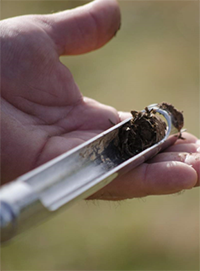 At MaxFacts, nitrogen is our No. 1 concern. It’s the input we’re always talking about, because it’s one of the most important — if not the most important — nutrients your customers need to grow a successful corn crop.
At MaxFacts, nitrogen is our No. 1 concern. It’s the input we’re always talking about, because it’s one of the most important — if not the most important — nutrients your customers need to grow a successful corn crop.
However, corn can’t live on nitrogen alone. Corn needs several other macro- and micronutrients to ensure a good yield. Those include elements like phosphorus (P) and potassium (K), which, unlike nitrogen, are relatively immobile in the soil and not always as vulnerable to loss. Knowing these nutrients are likely to stick around is a relief, but that doesn’t mean you don’t have to worry about them.
Why to Test Soil in the Fall
“When nutrients are immobile in the soil, we have to test the soil more often to see what the concentration is at Point X, Point Y, Point Z,” says John Jones, Ph.D., director of the Foundation for Agronomic Research. "So, we do that to understand what the availability will be for our growing crops."
“Soil testing is really a way of seeing what nutrients will be available for next year’s crop,” Jones says. “A routine analysis will check for phosphorus, potassium, pH, maybe organic matter and then elements like calcium, magnesium and sulfur.”
Develop a Soil Testing Rhythm
Jones recommends performing post-harvest soil sampling at least every two years at roughly the same time. “By doing the sampling at the same time each year, it’s essentially standardizing the environment that you’re pulling the samples from,” Jones says.
In the short term, the goal is to know how much of each nutrient your customer will need to apply for next year’s corn crop. In the long term, the ultimate goal is to find the relationship between the available nutrients and yield response and then be able to replicate positive results year after year.
“If we test across multiple years, hopefully over five to 10 years we start to understand what’s going on within the soil nutrient dynamics,” Jones says.
Which Type of Sampling to Use
If you’re wondering whether grid sampling or zone sampling is the best way to go, Jones says it depends.
By taking samples from zones with different soil properties, you can see which nutrients are needed where. “This way, you’ll better know what needs to be applied where, and you can tailor your applications more exactly,” Jones says.
Regardless of your sampling method, the key objective should be to obtain representative samples that catch the variability in each management unit, or each portion of the field that will be managed the same.
Jones says regular soil sampling is a better tactic than applying more nutrients and hoping for the best. “Soil sampling has a better return on your investment as crop prices decrease. That’s because you can really identify where to optimize input decisions,” Jones says.
And in an uncertain economy, it’s important to find those ways for your growers to save dollars without cutting back on essential inputs.
You can learn more about the Foundation for Agronomic Research by visiting the organization’s website.